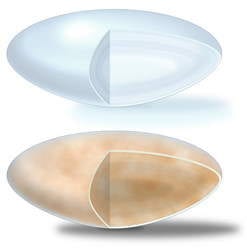Cataract Treatment In Everett, WA
What are Cataracts?
 Cataracts affect millions of people, including more than half of all Americans aged 60 and older. A cataract is a painless clouding of the eye’s natural lens that is caused by a buildup of protein. A cataract can form in one or both eyes. If left untreated, they worsen over time and interfere with everyday activities such as reading or driving. Night vision is usually most affected. When cataracts are in their early stages, people are helped by brighter lighting. As they get worse, however, most people require surgery.
Cataracts affect millions of people, including more than half of all Americans aged 60 and older. A cataract is a painless clouding of the eye’s natural lens that is caused by a buildup of protein. A cataract can form in one or both eyes. If left untreated, they worsen over time and interfere with everyday activities such as reading or driving. Night vision is usually most affected. When cataracts are in their early stages, people are helped by brighter lighting. As they get worse, however, most people require surgery.
If you suffer from cataracts in Everett WA and nearby areas, call today to schedule an appointment at Physicians Eye Clinic.
Risk Factors
In addition to aging, there are other risk factors that increase a person’s chances for developing cataracts:
- Excessive sun exposure
- Family history of cataracts
- High blood pressure
- Smoking
- Diabetes
- Obesity
- Excessive alcohol use
- Radiation from x-rays and cancer treatments
- Previous eye injury or surgery
- Prolonged use of corticosteroid medications
In rare instances, infants are born with cataracts, which may be the result of an infection, such as rubella, contracted by the mother during pregnancy. They may also occur in combination with some other birth defect. Occasionally, infants develop them shortly after birth.
Diagnosis
At Physicians Eye Clinic we have extensive experience diagnosing and surgically treating cataracts. We usually see cataracts during your regular comprehensive eye exams. Once we suspect a cataract, we check tonometry to measure the pressure inside the eye.
The most common tonometry test is to send a puff of air onto the eye to flatten the cornea and test eye pressure. At this point, we’ll test for sensitivity to glare and your color perception (both of which are affected by cataract lens clouding).
Symptoms of Cataracts
Cataracts cause a progressive, painless loss of vision, along with these cataract symptoms:
- Blurry vision
- Trouble with night vision
- Fading of color
- Increased sensitivity to glare
- Halos surrounding lights
- Double vision in the affected eye
- A feeling as if there is a film over the eye
- A need to frequently change eyeglass prescriptions
- Yellow-tinged vision
Treatment Options
Early cataracts can sometimes be treated with nonsurgical methods, including the following:
- New corrective-lens prescriptions
- Anti-glare sunglasses
- Magnifying lenses
- Brighter lighting
If they begin to interfere with reading ability, work, night driving or other daily activities, cataract surgery may be recommended. If they are in both eyes, surgery is performed, usually 4 to 8 weeks apart, on one eye at a time. Cataract surgery is the most common surgical procedure in the United States.
Prevention of Cataracts
Although cataracts cannot be prevented, their development can sometimes be delayed by the following:
- Wearing wide-brimmed hats to block sunlight
- Wearing sunglasses that block ultraviolet rays
- Not smoking; not drinking excessively
- Eating a diet high in antioxidants
Left untreated, cataracts cause serious visual impairment. In most cases, however, they can be effectively treated with surgery once they become intrusive in everyday life.
How many days rest is needed after cataract surgery?
While each person heals at different rates, many patients report drastically better vision within the first 24 hours of their cataract surgery. Plan on taking one to three days off work to be sure you have enough time to rest, but you can plan on getting back to most of your normal activities within just a couple days.
At what age to cataracts typically form?
Aging is the common cause of cataract formation. This is due to normal changes in the eyes that begin to happen after the age of 40. That is when normal patterns in the lens start to break down, and this is what causes the lens to get cloudy. Cataracts develop in most people after they hit their 60th birthday, although they may not hinder vision to a noticeable degree until years later.
How long does it take for blurriness to go away after cataract surgery?
As mentioned above, vision improves in most patients within the first 24 hours after their surgery, but some amount of blurriness is common in that eye. This can continue for a few days, but it doesn’t last long. Again, this varies with different patients.
Will I ever need cataract surgery again in the future?
If you’ve had a cataract develop in one eye and have had it removed and replaced with an intraocular lens, it’s likely that your other eye will also need surgery. This isn’t always the case, but it is common. If one eye has an advanced cataract, while the other eye is just beginning to cloud, patients will still opt to have both eyes addressed because the eye with the lesser degree of clouding will only continue to become cloudier.
At Physicians Eye Clinic, we don’t perform cataract surgery on both eyes at one time. We usually advise patients to wait from 4 to 8 weeks after their first surgery to schedule the surgery on their other eye.
What are the benefits of having cataract surgery?
You could say, “What are the benefits of having clear vision again?” Once cataracts have clouded your vision it can seem as if you’re continually looking through a dirty window. When your Physicians Eye Clinic ophthalmologist removes the clouded natural lens and replaces it with an artificial intraocular lens (IOL) your vision in that eye is instantly clear again and colors will be dramatically more vivid. Plus, the new IOLs can provide clear vision at all distances, and they can even correct for presbyopia, the near universal condition where we need reading glasses for up close vision after we turn 40.
What do I need to do to prepare for cataract surgery?
About one week before your scheduled procedure in our state-of-the-art surgical center, we’ll perform an ultrasound test to measure the size and shape of your eye. This helps determine the right type of lens implant you’ll need.
Prior to this appointment, you will have been advised to do research on your own into the different types of intraocular lenses available. Our doctors will discuss the pros and cons of each option with you. Technology has continued to expand the choices for IOLs in exciting new ways. Just 20 or so years ago, patients only had the choice of fixed focus monofocal IOLs, and they would decide whether to choose distance vision or up-close vision for their focal range, using eyeglasses to correct for the other distance. Today, there are multifocal and accommodating focus IOLs that can deliver clear vision at all distances. The newest options in these IOLs can even correct for astigmatism and presbyopia.
So, while there isn’t anything to do to physically prepare for your surgery, you’ll want to learn all you can about your choices for intraocular lenses. Of course, we’ll help you with this important decision.
What is recovery like after cataract surgery?
Recovery after cataract surgery is not difficult at all. After your surgery with one of our three ophthalmologists, you’ll have an eye patch on your treated eye. You will need to wear a protective shield, even when sleeping, for several days. At first your vision will be blurry, but it rapidly improves in just a couple days. Your eye may be somewhat itchy, but you must not rub or put any pressure on the treated eye. Heavy lifting, or anything that puts pressure on your eyes, must be avoided. We’ll provide eye drops to prevent inflammation and infection and to control your eye pressure.
Full healing can take up to two months, but you can return to most daily activities in just a few days. Depending on your lens choice, you may or may not require glasses for some tasks after your surgery. If both your eyes have cataracts, we schedule the second eye for surgery one to two months after the first; they are not done at the same time.
Contact us Today!


